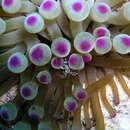Brief Summary
provided by EOL authors
The spotted cleaner shrimp (Periclimenes yucatanicus) is a brightly colored shrimp which have been observed to remove and eat parasites, injured tissue, and possibly undesirable food particles from a large variety of cooperating reef fishes. This symbiotic behavior is so well developed in some cases that the shrimps are invited to enter the mouths and gill cavities of their hosts, apparently with complete immunity from being eaten.These shrimp are a important aset to their ecosystems. They are, together with certain fishes that also clean, seemingly responsible for the control of gill, oral, and external parasites of the various reef fishes.
Morphology
provided by EOL authors
This is a small species, usually less than three centimeters in body length. The antennae are longer than the body. The body and legs are smooth. The body is transparent except for several distinct, large, white and tan saddles and spots. There is a large saddle of light tan bordered with white on the carapace. The eyes are white, tipped with red. The eyestalks have a fine stippling of red and white dots which extends over the rostrum and the anterior part of the carapace and onto the antennular and antennal peduncles. The outer part of the antennules are white with an extended orange saddle at their bases.
Distribution
provided by EOL authors
Spotted cleaner shrimp (Periclimenes yucatanicus) is widely distributed between southern Florida and Colombia and is frequently observed off Bahamas, Virgin Islands, and Puerto Rico.
Habitat
provided by EOL authors
Spotted cleaner shrimp inhabit areas near anemones in warm trpoic waters. The shrimp are either resting on the anemones or occupying the same crevice. Two anemones which this specific shrimp are found near include Bartholomea annulata (Lesueur) and Condylactis gigantea (Weinland).
Behavior
provided by EOL authors
In the presence of fishes, and sometimes just in the presence of the observer, these shrimps may lash their antennae together and sway back and forth. Shrimp have to be careful of which fish they clean because some fish mimic other and try to eat the shrimp.
Spotted cleaner shrimp
provided by wikipedia EN
The spotted cleaner shrimp (Periclimenes yucatanicus), is a kind of cleaner shrimp common to the Caribbean Sea. These shrimp live among the tentacles of several species of sea anemones. They sway their body and wave their antennae in order to attract fish from which they eat dead tissue, algae and parasites.
Description
The spotted cleaner shrimp grows to a length of about 2.5 cm (1 in). It has a transparent body patterned with brown and white saddle shaped markings. The chelae and legs are boldly striped in red, purple and white. There are two pairs of long white antennae banded in black.[1][2]
Distribution
The spotted cleaner shrimp is found at depths down to about 24 metres (79 ft) in the Caribbean Sea, southern Florida, the Bahamas and as far south as Colombia.[2][3]
Life cycle
Breeding takes place in the summer and females have been seen brooding eggs under their abdomens in the months of July and August.[2] After hatching, the larvae pass through several planktonic larval stages before settling on the seabed and undergoing metamorphosis into the adult form.[4]
Ecology
The spotted cleaner shrimp lives in close association with a sea anemone, either Condylactis gigantea, Lebrunia danae, Bartholomea lucida or Bartholomea annulata.[5] It lives among the tentacles and up to six individual shrimps have been seen on one sea anemone. It swishes its antennae around in the water to attract the attention of passing reef fish. When they pose motionless beside the anemone, it emerges from the tentacles and removes and feeds on external parasites and flakes of loose skin from the fish.[1][2] It even enters the mouths of fishes and cleans behind their gill covers apparently with no likelihood that it will get eaten.[6] It has also been found associated with the sea anemone Rhodactis sanctithomae in the US Virgin Islands, a species of anemone not previously recognised as a symbiont species.[5] Also in the Virgin Islands, it has been seen on the tentacles of the jellyfish Cassiopea.[2]
References

- license
- cc-by-sa-3.0
- copyright
- Wikipedia authors and editors
Spotted cleaner shrimp: Brief Summary
provided by wikipedia EN
The spotted cleaner shrimp (Periclimenes yucatanicus), is a kind of cleaner shrimp common to the Caribbean Sea. These shrimp live among the tentacles of several species of sea anemones. They sway their body and wave their antennae in order to attract fish from which they eat dead tissue, algae and parasites.
- license
- cc-by-sa-3.0
- copyright
- Wikipedia authors and editors
Depth range
provided by World Register of Marine Species
Shallow-waters (0-100 m)
Poupin, J. (2018). Les Crustacés décapodes des Petites Antilles: Avec de nouvelles observations pour Saint-Martin, la Guadeloupe et la Martinique. Muséum national d'Histoire naturelle, Paris, 264 p. (Patrimoines naturels ; 77).
- license
- cc-by-4.0
- copyright
- WoRMS Editorial Board

